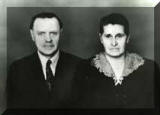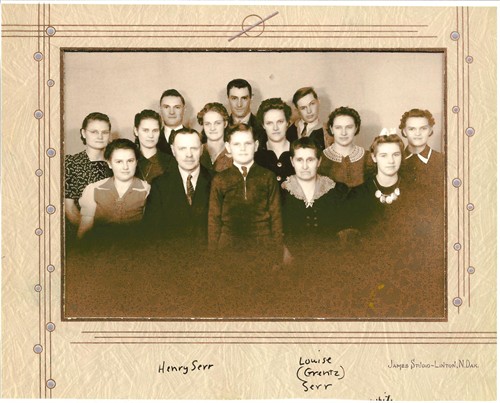 |
|
Henry and Louisa (Grenz) Serr |
|
Louisa (Grenz) Serr
and Henry Serr
Quoted from: Serr
Reunion focuses on family's history in Emmons county Alan
Burke, Editor
Emmons County Record, Linton,
North Dakota, December 21, 2005
About 230 descendants of Henry, Sr. and Louisa
(Grenz) Serr gathered June 17-19 for a family reunion
that included visits to the Serr farms, the Emmons County
Historical Society Museum in Linton and to Hot Spot
Pizzeria in Linton for a family meal. The family
headquartered at a Bismarck motel.
Their first stop on their tour of the area was the
farmstead where Henry and Louisa lived. Henry’s parents,
George, Sr. and Elizabeth (Enzi) Serr and his brother and
sister-in-law, George, Jr. and Johanna (Stoppe) Serr,
lived in the same area.
Only a few out buildings remain on the Henry, Sr.
farmstead, and the land is now owned by Albert
Henry, Sr. and Louisa raised 14 children on their farm
west of Temvik. Near the farm is the Sand Creek Cemetery
where two generations of the Serr family are buried:
George, Sr. and Elizabeth and George, Jr. and Johanna.
Henry, Sr. and Louisa are buried in the Linton Cemetery.
Also on the tour was the former St. Andrew’s Episcopal
Rectory in Linton where Henry, Sr. and Louisa lived after
they moved to town. Family members who visited the Serrs
at the former rectory remember its cathedral ceiling and
the lemon drops that Grandma Serr kept in a drawer in the
kitchen.
Lucinda Schneider of the Emmons County Historical
Society, which now uses the house as part of its museum,
stocked the drawer with lemon drops as a treat for the
Serr family.
At the museum, Henry Serr, Jr. and his children: Terry
Serr and Candis Wagner, both of Hazelton, and Shelley Serr
of Bismarck presented Schneider with a framed picture of
Henry, Sr. and Louisa that now hangs in their former home.
Henry, Sr. died in 1952 and Louisa in 1974.
The Serr family paid their respects at the Serr graves
in the Linton Cemetery and then to the Grenz relatives -
Gottlieb and Johanna (Heer) Grenz - in the Temvik
Cemetery.
In addition to the tours, the family especially enjoyed
their meals together in Linton and in Bismarck.
Family history
Dorinda (Serr) Diede compiled a family history, which
she presented to those attending the reunion.
Her history starts with George Serr, Sr., who was born
in Worms, Russia, in 1849. He married Elizabeth Enzi in
New Freudenthal, Russia, in 1874. He was 25, and she was
19.
George and Elizabeth had seven children, who ranged in
age from 4 to 34 when the family immigrated to the United
States in 1903. During his years in Russia, George, Sr.
was taught the practice of herbal medicine, and he
continued treating both people and animals after coming to
the United States. He was known as a "braucher," a German
term for a "laying on of hands" type of healing.
George and Elizabeth homesteaded on the NW1/4 of
Section 24-133-77 in Emmons County, which was four and a
half miles southwest of where their son and his wife,
Henry, Sr. and Louisa Serr, eventually purchased land and
settled to raise their children. Elizabeth died in 1916
while George lived until 1931.
Henry, Sr. worked for the Harold Brothers, who were
contracted by the Northern Pacific Railroad, to supply hay
for the mules used in the construction of the rail line in
Emmons County. The haying was done a quarter mile west of
the Linton Cemetery.
When Henry was 23, as customs of that time dictated, a
marriage was arranged for him. His bride was Louisa Grenz,
also 23. She was the daughter of Gottlieb and Johanna (Heer)
Grenz, and they were married in Zeeland on Jan. 27, 1908.
Louisa was born in 1885 in Guldendorf, Russia, and was
a baby when her parents brought her to the United States.
The Grenz family lived near Artas and Eureka in South
Dakota for about 23 years, before moving to Emmons County.
There were 14 children in the family.
Shortly after Henry and Louisa were married, the
Grenzes purchased land in Emmons County from Gottlieb
Schatz. The land came with a sod house built by Schatz.
Gottlieb Grenz was one of the founders of the Temvik
Zion Lutheran Church in 1930. Gottlieb died in 1936,
followed by Johanna in 1946. Following their wedding day,
Henry and Louisa traveled west, crossing the Missouri
River on a ferry with all their personal belongings,
including a buggy and two horses.
They homesteaded near Lemmon, S.D., and returned to
Emmons County about three years later. Their first child,
George, died on the homestead and was buried in the Lemmon
Cemetery.
Henry and Louisa had 13 children in Emmons County.
Their births spanned 19 years, so all 13 were not living
at home at the same time. The children left home between
the ages of 15 and 18 to get jobs to support themselves
and sometimes to help support the family.
Henry Serr, Jr., is the youngest child of Henry and
Louisa. He and his wife, Edna, farm southwest of Hazelton.
Henry has one living sister, Martha (Haas) Roe of Olympia,
Wash.
Some of the family lore includes a story about Henry,
Jr. and his older brother, Robert. When the boys wanted to
use the family car, Robert would always have Henry ask their father
for the use of the
automobile, since it appeared their father would give in
more easily to the baby of the family.
Once when Robert and Henry used their father’s car,
Robert had an accident that resulted in a smashed fender.
They put the car in the shed and didn’t tell their father.
Henry, Sr. eventually noticed the damage but didn’t seem
very angry; however, the boys ended up having to use their
horses to go places for a very long time after that. The
Serr family history tells about Henry and Louisa’s life on
the prairie and raising their children in Emmons County.
Both the hard times and the good times are included.
By Alan Burke, Editor
Emmons County Record, Linton, North
Dakota, December 21, 200
 |
|
The Henry Serr Family |
 |
|
Henry's and Louisa's Sod House |
|
|
| The summer kitchen,
car shed and granary building and the chicken coop are
among the out buildings that still stand on the former
Henry, Sr. and Louisa Serr farm. |
|
|